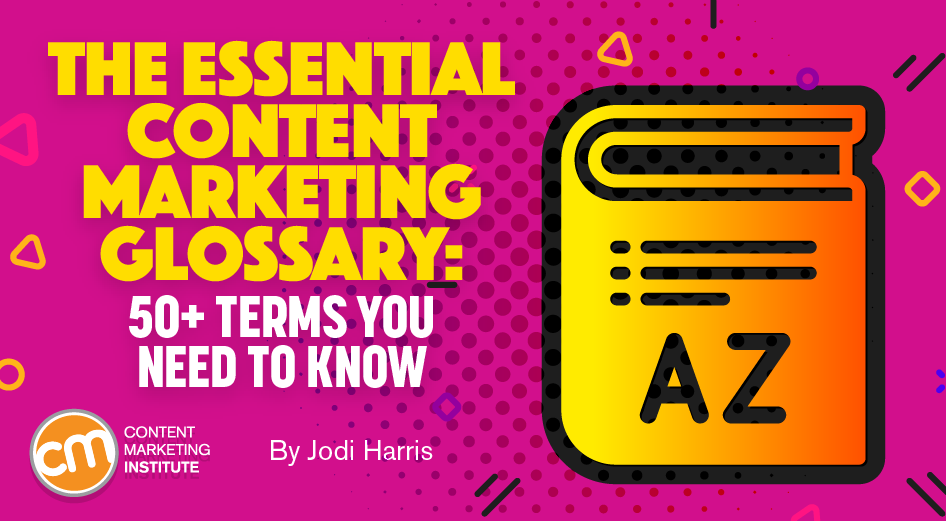MARKETING
50+ Terms You Need To Know

On the surface, content marketing seems straightforward: Create great content, publish it on channels popular with your audience, and reap business benefits from their attention and interest.
Of course, we all know there’s a lot more to it. But it can be hard to dive into the nuances, complexities, and conditional decision-making when struggling to understand the basic principles, techniques, and tactics. Even seasoned veterans can interpret key terms differently, leading to challenges in communicating and implementing strategies.
You can’t dive into the complexities of #ContentMarketing until you know many of the terms. That’s why @joderama developed this glossary via @CMIContent. Click To Tweet
To help clear the confusion, I put together this glossary of common content marketing terms. While consensus on all definitions isn’t possible, it is possible to have your team agree, and that’s the strong foundation needed.
Note: I organized these definitions into best-fit categories though many can span multiple areas.
Strategy-centric terms
Audience
In a marketing context, audiences are targeted, clearly defined groups of individuals and/or organizations that willingly read, listen, view, or otherwise engage with your brand’s content in exchange for benefits they expect to receive.
Definitive resource: Your Audience Is Not the Same as Your Marketing Database
Buy-in/business case
A business case captures the reasoning for an organization to invest in content as a component of its marketing strategy. Typically delivered to executive management in the form of a document or presentation, it’s a helpful tool for building stakeholder understanding and support necessary to execute the program effectively.
Though talking points can vary, at a minimum, your business case should address:
- Why your company needs content marketing
- How it can help your organizations meet its marketing goals
- Necessary budget and resources
- Expected outcomes and estimation of when they will be achieved
Definitive resource: How To Make a Better Case for Content Marketing in 2021
Content marketing
CMI defines content marketing as “a strategic marketing approach of creating and distributing valuable, relevant, and consistent content to attract and acquire a clearly defined audience – with the objective of driving profitable customer action.”
But as A. Lee Judge recently asserted, content marketing is more than a marketing strategy that uses content to attract an audience – it’s a skill set. “It’s no longer enough to market with content. You must understand how to market the content itself,” he says. Thus, he offers a complementary expansion to the definition as a verb: “Applying marketing skills and techniques to written, visual, audio, or social content to provide the greatest possible reach, longevity, and effectiveness of that content.”
#ContentMarketing is both a discipline and a skill set, says @joderama and @aleejudge via @CMIContent. Click To Tweet
Definitive resource: Are Inbound Marketing and Content Marketing Still Different in 2021?
Content marketing strategy
Copyblogger defines content marketing strategy as a plan for building an audience by publishing, maintaining, and spreading frequent and consistent content that educates, entertains, or inspires an audience. However, CMI uses a simpler definition: Your content marketing strategy is your why – why you are creating content (your business goal), whom it will serve (your audience), and how it will be unique (your mission).
Definitive resource: Developing a Content Marketing Strategy
Content strategy
Content strategy operates above a content marketing strategy. It is a plan for creating, managing, and distributing all content produced and shared across the enterprise – not just the content used as part of a content marketing program or initiative. For example, how content is designed and developed to deliver an optimal user experience is a consideration that would fall under a content strategy, not a content marketing strategy.
Content mission statement
A content mission statement is the centering principle of your brand’s unique vision of content. Ideally, this statement reflects your business values, distinguishes your storytelling from competing content, and governs your content team’s creative and strategic decision-making, including:
- What stories your brand will tell (e.g., topics)
- How those stories take shape (e.g., core content formats and platforms)
- How your content assets work collectively to create a desirable experience for your audience
Definitive resource: Make a Mission Statement for Better Content Marketing
Goals
Goals can be defined as the business outcomes to be achieved through your content marketing strategy. While the ultimate goal is to drive profitable action, program goals should be more specific, such as to grow sales, to save the company money, or to drive greater customer loyalty and brand satisfaction. Goals also must be measurable and have a designated achievement date.
Definitive resource: How To Set Content Marketing Goals That Matter to Business Leaders
Personas
A persona is a composite sketch of a target audience’s relevant characteristics based on validated commonalities. Used to inform your strategic plans for reaching, engaging, and driving your audience to take meaningful action as a result of your content. Without well-researched personas, you likely guess what your audience wants and often revert to creating content around what you know best (your products and company) instead of around what your audience actively seeks.
Definitive resource: Marketing Personas: A Quick and Dirty Guide
Planning/Process-centric terms
Channel/media planning
Media planning is the process of making decisions about where, when, and how often to deliver a message to an audience. The ideal is to reach the biggest number of the right audience members with the right message only as often as needed to achieve the desired effect (e.g., brand awareness, leads, sales).
Similarly, a channel plan – including social media planning – is an advanced directive for how your brand manages its content on the ever-evolving list of media platforms. It spells out the rationale and the expectations for using each channel. Compiling this guidance ensures you aren’t wasting time – and budget – on distribution efforts that can’t help you achieve your content marketing and business goals.
Definitive resource: Social Media Content Plan: Take Control of Your Strategy
Content brief
Often provided to freelancers, consultants, and other outsourced writers assigned to create content, a content brief documents the guidelines and instructions to ensure a properly focused asset that meets the brand’s editorial standards and marketing expectations. A well-constructed brief should include an elevator-pitch description of the assignment, relevant branding details (e.g., tone, voice, and stylistic considerations), key messages, and target audience insights.
A well-constructed #content brief includes an elevator-pitch description of the assignment, target audience, and key messages, says @joderama via @CMIContent. Click To Tweet
Definitive resource: How To Create a Good Brief for Better Content Marketing
Content inventories and audits
According to Paula Land, author of Content Audits and Inventories: A Handbook, a content inventory is a collection of data about your content. It’s a comprehensive, quantitative list – typically created in a spreadsheet – of all content assets, ideally across all content types, channels, and distribution formats. It enables marketers to make data-based content decisions.
In contrast, a content audit, as defined by Paula, is a qualitative evaluation of the inventoried content. Assess your content against customer needs and business objectives to identify which assets are performing well (and which aren’t.)
Definitive resource: A Simple-To-Do Content Audit With 6 Questions
Content/editorial plan
A content or editorial plan is a tactical outline to execute your strategy that denotes responsible team members. It should detail such things as key topics, content to create, publication dates, distribution plans, and calls to action.
Definitive resource: How To Create a Flexible Content Plan That Gets Results
Content operations
Content operations are the full complement of processes, tasks, people, and procedures to manage efficiently and effectively everything content-related within your organization, from strategy and planning to governance, execution, measurement, and optimization.
Definitive resource: How to Build a Content Operations Framework (and Why You Need One)
Editorial calendar
An editorial calendar is a process tool to track all the moving parts in executing your content plan. It typically includes the topic, title, author information, and images for each asset and the schedule for publication and promotion organized according to workflows established for creation and production.
Definitive resource: How To Create a Strategic Editorial Calendar
Content workflow
Workflows are sets of tasks that a team needs to complete a content asset. In her book, Content Strategy for the Web, Kristina Halvorson says a content workflow determines “how content is requested, sourced, created, reviewed, approved, and delivered.”
At a minimum, they should outline critical tasks at each stage of the editorial process. Here’s a simple example:
- Outline
- Write
- Review
- Edit
- Approve
- Publish
Definitive resource: Marketing Workflow: How To Keep Content Production on Track
Creation-centric terms
Copy editing, proofreading, and fact-checking
These editorial techniques are used to ensure the highest level of quality, clarity, and accuracy in content. Each serves a different purpose and uses distinct approaches:
- Copy editing: This involves reviewing and editing content for any mechanical errors or stylistic inconsistencies that might impact the quality or readability of the piece. Tasks include checking written material for grammar, spelling, linguistic, or punctuation issues. A copy editor may also do a rewrite, if necessary, to fix problems with transitions, wordiness, jargon, and style.
- Proofreading: Proofreading is a separate stage of the editing process. Here, a proofreader scrutinizes the content in its almost-published state to catch any typographical or minor errors that were missed in editing or created during production.
- Fact-checking: Fact-checking is then conducted to verify the factual accuracy of the content and its use of sourcing. It ensures the content doesn’t spread disinformation, miscredit or misquote sources, get dinged for plagiarism or copyright infringement, or otherwise risk losing the trust of your audience (and possibly face legal penalties.)
Definitive resource: The Best Proofreading and Editing Tips (Spoiler: Don’t Do Them at the Same Time)
Curation
Curation is the assembly, selection, categorization, commentary, and presentation of relevant content. The technique typically involves third-party content in which your brand puts your spin on others’ content. It also can be applied to curating content published by your brand.
Definitive resource: Content Curation on Social Demands More Than a Shared Link
Distribution/promotion-centric terms
Accessibility
Accessibility is the ease anyone should have navigating, understanding, and using your content. Often used in the context of conditions, such as visual or auditory impairments, such as someone who prefers to mute videos and read the captions.
Calls to action (CTAs)
Calls to action are statements or design elements highlighting actions you want the audience to take after engaging with the content, such as subscribing to your newsletter, attending an event, or exploring other relevant assets and offerings. The best CTAs are simple, clear, inviting, and easy to notice.
Channels
Channels are individual content distribution outlets, such as a blog or podcast channel, Facebook, Twitter, TikTok, YouTube, or Vimeo.
Formats
A content format refers to where the content can be accessed or its presentation for distribution and engagement, such as text via in a printed book, a digital magazine, or an SMS campaign; audio for a podcast; or visuals for like a video or infographic.
Keywords/key phrases
Keywords or key phrases describe the contents of a content asset based on terms people use to search for content on that topic. They are the building blocks of a search engine optimization (SEO) strategy.
Owned media
Owned media distribution platforms are fully under your brand’s control, allowing you to decide where and how it appears, how it is accessed, and how it fits in with other aspects of the content experience.
Shared/social media
Shared media, including social media, provide opportunities for marketers to post content, create and listen to conversations, and interact with people. These platforms are ultimately controlled by a third party, which can change its policies and procedures – or cease operations altogether – at a moment’s notice.
Native advertising
Native advertising is a paid/third-party promotion format that supports either brand or direct-response goals and is where the content matches the form, feel, function, and quality of the content of the media on which it appears.
Definitive resource: How to Do Native Advertising Right: A Brief Guide With Great Examples
Branded content
Wikipedia defines branded content as content funded or outright produced by an advertiser. Like native advertising, it works by partnering with relevant publishers that have the trust of your target audience. This technique takes a more immersive, sensory-driven approach to storytelling, making the experience more entertaining, valuable, and memorable.
Paid search
These opportunities typically take the form of pay-per-click ads or other sponsored listings that appear near the top of search engine results pages (SERP) when consumers search for information relevant to your content.
Influencer marketing
One of the fastest-growing marketing techniques (as well as a burgeoning industry of its own), influencer marketing programs enlist the assistance of people who have the ear of your target audience to bring your content to their attention.
Definitive resource: How to Turn Influencers into a Powerful Content Force
Content personalization
Personalization is the process of targeting content to individuals based on one or more of the following: who they are; where they are; when, why, and how they access content; and what device they use to access it. Given the high competition for getting attention online, marketers use this technique to make their content more findable, engaging, and personally resonant to their target consumers and existing customers.
Search engine optimization (SEO)
SEO is a set of strategic techniques and tactics designed to get content to rank as highly as possible on search engine results pages (SERP) on Google and other search sites. The higher your content ranks, the more likely it is to receive a click, which increases traffic to your content.
Definitive resource: Providing the Best Answer May No Longer Be the Best Strategy for SEO [Video Series]
Content segmentation
Segmentation refers to the categorization of content based on the target audience niche (similar to a buyer persona). Content is presented in a clear and concise manner specific to that audience. Often affecting design, messaging, and presentation, content segmentation can improve engagement, better differentiate your brand from competitors, and improve content marketing effectiveness.
Definitive resource: 8 Expert Tips To Help You Personalize Your Content and Segment Your Audiences
Sales-centric terms
Account
Account is defined as a sales target, opportunity, or customer group established within the total addressable market.
Account-based marketing (ABM)
ABM is a B2B marketing approach where high-value (typically enterprise-level) organizations are identified, and content is created to target them as a grouped unit rather than marketing to individual members of that organization.
Definitive resource: Account-Based Marketing (ABM) Crash Course for Content Marketers
Buyers
Buyers are prospects – people who are in need of, or have an active interest in, purchasing a service or product.
Consumers
While the term is often used interchangeably with “buyers,” from a marketer’s perspective, consumers are the people who are likely or intended customers for their business.
Customers
While buyers and consumers are terms used to indicate interest or intent, customers are the individuals or organizations who have actively made a purchase from your business or brand.
Conversion
A conversion takes place once a consumer has taken an action your organization designates as meaningful – such as purchasing a product, registering for an event or a gated asset, subscribing to a blog, newsletter, or joining a social media community – after engaging with your brand’s content.
Definitive resource: How To Create High-Converting Content
Demand generation
Demand generation is the focus of targeted, sales-centric marketing programs designed to drive awareness and interest in a company’s products and/or services. The greater the demand, the easier it becomes for sales to nurture that interest to convert.
Definitive resource: Demand Gen for Content Marketing in the Next Decade [New Research]
Ideal customer profile (ICP)
An ICP is a description of a targeted buyer (person or company) that’s a perfect fit for your brand’s solution.
Journey map
This term refers to a method of identifying information and assistance consumers likely need at each possible interaction and is used to determine the most effective content to nurture them toward conversion.
Definitive resource: Wondering What Content To Create? Try a Customer-Journey Map
Lead
In marketing terms, a lead is a person or business in your company’s sales or marketing database, typically (though not exclusively) by engaging with a branded asset or communication platform.
Definitive resource: Make Content Integral to Your Lead Generation
Lead scoring
Scoring is a marketing method of objectively and comparatively evaluating the quality and conversion potential of a prospect based on predetermined sales criteria.
Marketing-qualified lead (MQL)
MQLs are leads reviewed by the marketing team that satisfies the criteria to be passed along to the sales team as someone who may become a customer at some indeterminate point.
Sales funnel/funnel stage
The sales funnel is a method of defining the decision-making process of a customer from the time they enter the marketplace through the purchase (or conclusion not to buy). It’s commonly used to determine the most effective outreach approach to nurture conversions. (While marketers may also define customer decision-making in terms of funnel stages, content marketers are more likely to characterize these stages as progression along a journey.)
Sales-qualified lead (SQL)
Once a lead is qualified by the sales team as being active in the market, they are referred to as an SQL; these leads are more likely to become a customer than an MQL.
Total addressable market (TAM)
This is a calculation that references the total number of prospective buyers and/or potential revenue opportunity available for a product or service.
Definitive resource: Build a Stronger Pipeline With Content: Unlock the Power of Sales and Marketing Collaboration
Measurement-centric terms
A/B testing
This is a performance testing method that pits two pieces of content against each other to gauge comparative performance. Also known as split testing, it’s a randomized experiment where two possible version options — two web pages, two subject lines, two design strategies, two content angles, etc. — are presented in equal scale to different viewers.
Analytics
Marketo defines analytics as the practice of managing and studying metrics data to determine the ROI of marketing efforts like calls to action, blog posts, channel performance, and thought leadership pieces, and to identify opportunities for improvement.
Key performance indicators (KPIs)
KPIs are standard, agreed-on measurements for assessing progress against your content marketing goals. Potential KPIs might be average conversion rates, number of leads, quality of leads, revenue per new customer, etc.
Metrics
In contrast to KPIs, metrics are the business-as-usual measurements that quantify things that add value to your organization but aren’t focused on the most critical goals, such as website page views or “likes” on a social media post. Think of these as the “what-needs-to-be-true” numbers that can help you achieve or optimize your KPIs.
Definitive resource: These 4 Analytics Oversights Mess With Your Content Performance Plan
Return on investment (ROI)
ROI is a broad term that describes how a company’s marketing initiatives drive profitable actions and business growth. Knowing ROI for content campaigns enables marketers to determine appropriate budget allocations, maximize the efficiency of each marketing expenditure, and demonstrate the impact of their efforts to their executive stakeholders. However, though it’s (arguably) the most critical measurement of a content program’s effectiveness, it can be difficult to calculate and quantify, let alone prove definitively.
Definitive resource: How To Demystify the Process of Measuring Content Marketing ROI [Video Show]
Subscribers
In content marketing, subscribers are defined as audience members who have taken an action around your content (and provided some personal data to do so) in exchange for an expectation of receiving ongoing value; core metric for measuring content marketing value.
Understanding the language is the first step to success
While this glossary is by no means a comprehensive list, it should clarify commonly confused or misunderstood industry terms and concepts. If there are additional content marketing constructs that you would like to see us add to this list, let us know in the comments.
Cover image by Joseph Kalinowski/Content Marketing Institute
















You must be logged in to post a comment Login